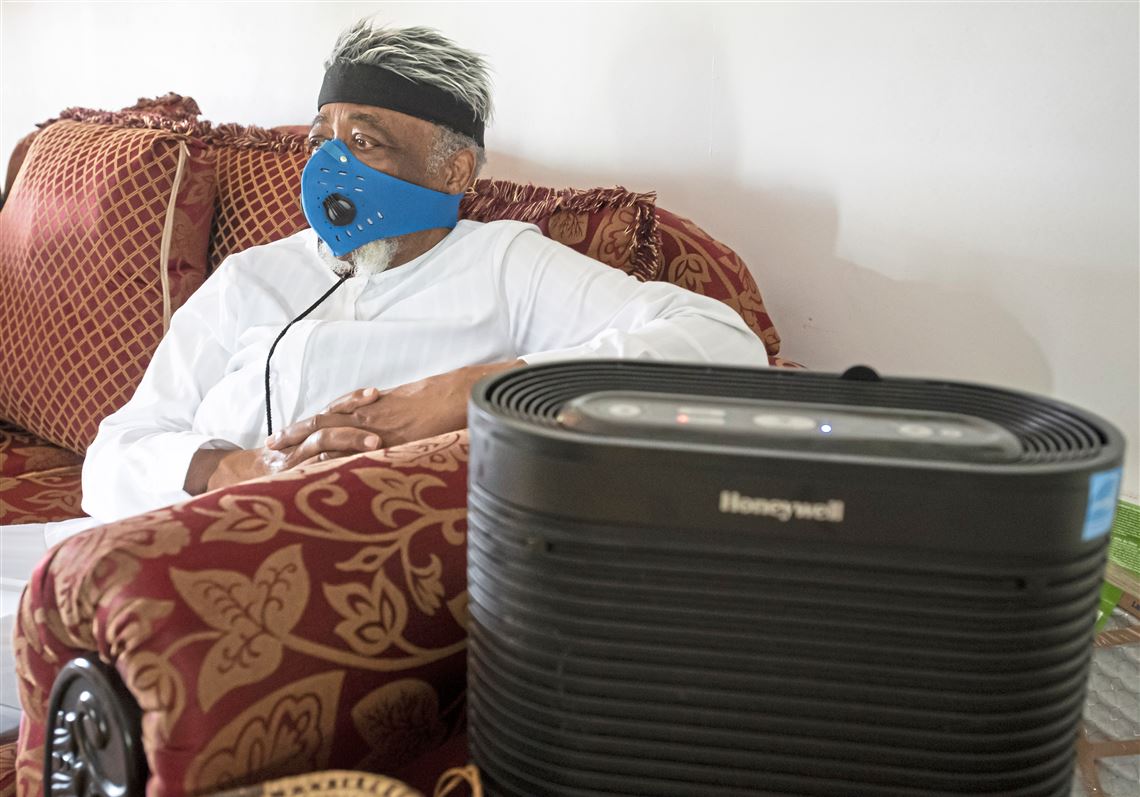Portable Air Cleaners

Our work with air filtration has shown that it’s possible to reduce indoor particle pollution by up to 90%! Reducing exposure to these particles can be especially beneficial for vulnerable occupants such as children, the elderly, and people with asthma or pulmonary disease. For renters, office workers, and some homeowners, however, building-wide interventions to improve air quality may not be possible. Portable air cleaners offer simple solutions for minimizing particle exposure and can be targeted to filter the air in the spaces where people spend most of their time.
According to William Fisk (LBNL), one of the best ways to improve indoor air quality “comes from using better filtration to reduce indoor concentrations of outdoor PM, thus reducing the morbidity & mortality associated with outdoor air PM. . . . The health benefits are predicted to far exceed the costs for those interventions.”
In July 2020, ROCIS worked with a team of community leaders and organizations to provide portable air cleaners to selected households in Clairton, PA, and help participants learn how best to use them effectively. More information about the Clairton project and the products we tested can be found below.
Air Cleaner Basics
What do you need to know about air filtration?
This half-hour video offers a complete primer on air filtration. Assembled from presentations given by the ROCIS team, we cover everything from portable air cleaners to DIY fan/filters.
What is a portable air cleaner (PAC)?
-
- Sometimes called an air purifier, a PAC is a device for filtering pollutants (mostly particles) from indoor air.
- PACs filter the air in a single room or area of the house, not the whole house. Choose an air filter that has the correct clean air delivery rate (CADR) for your space.
- Although some types of filters (especially carbon filters) may reduce pollutants such as gases, vapors, or fumes, there is no standard for these pollution levels and such filters cannot be certified.
Tips for making the most of your portable air cleaner:
-
- Be sure your filter has a HEPA filter (not HEPA-like)
- The best air cleaners work by filtration alone. It is debatable whether “additive” air cleaners—employing technologies such as plasma wave, ionization, or photocatalytic oxidation (PCO)—actually work in a real home or school setting. Furthermore, the injection of additives may contribute to the formation of harmful pollutants. For more information on electronic air cleaners, check out this article from Mother Jones and this blog post from Energy Vanguard.
- PACs provide the greatest benefit when they stay on for long stretches of time to provide baseline filtration. Steer clear of cleaners that only turn on when there is a spike in particles.
- Using low-cost air monitors can help gauge the effectiveness of air cleaners and identify key sources of pollution.
- The tighter the house, the greater the impact of filtration. (But remember that in tighter buildings, you will need to do more to control indoor sources of pollution.)
- Pay attention to where occupants are most likely to be exposed to pollutants. Where do you spend the most time? Bedrooms may be a good example. Run a PAC consistently in these rooms to reduce human exposure.

For more information about air cleaners, check out this EPA guide to air cleaners and air filters.
DIY Air Cleaners
There are a lot of portable air cleaners available commercially, but they can be expensive. An affordable and effective air cleaner can be constructed from a box fan and MERV 13 air filters, either by securing a single filter to a fan or creating a box of four filters. Instructions for both types of fan/filters are included below.
The fan/filter can be placed in a window to filter outdoor air as it comes into your home, or it can be used within a space.
Through our Low Cost Monitoring Project participants, we have seen a significant reduction of particles (0.5+ microns) in homes with the use of a fan/filter.
Note: the fan/filter is not designed to reduce other kinds of pollutants such as gases or vapor.

Materials
- MERV 13 20×20×4” furnace filter
- 20×20″ box fan
- Foil-faced duct tape or cellophane tape
- Scissors/utility knife
Steps
- Find the arrow indicating airflow on the filter; make sure this matches the direction of the fan’s airflow.
- Place the filter on the box fan. We recommend placing the filter on the front of the box fan if placed in a window. The filter can be placed on the back of the box fan if used to recirculate the air within a room.
- Secure the filter to the fan by using tape; completely seal the filter to the fan with tape.
- Plug in the fan/filter and run on low. Your DIY fan/filter is complete!
- Change the filters as needed. A 4″-deep filter should last for 6 months of continuous use if used within a room rather than to filter air coming in a window.


CORSI-ROSENTHAL INSTRUCTIONS: Four Filters
Well-suited for larger indoor spaces.
Materials
- Four (4) MERV-13 20×20×2” furnace filters (1-inch filters can be used but may need to be replaced more frequently)
- 20×20″ box fan
- Two (2) pieces of cardboard (< 20×20″)
- Foil-faced duct tape or cellophane tape
- Scissors/utility knife
Steps
- Find the arrow indicating airflow on the filters; construct a box with the four filters with the airflow moving from the outside of the box to the inside. Tape the filters securely together (without blocking the media filter).
- Tape one of the pieces of cardboard to one open side of the filter box (this will be the bottom).
- Check the airflow direction of your box fan. Tape the box fan to the top of the cube with the airflow pulling air out of the box.
- Optional (for improved performance): Cut a circle in your second piece of cardboard that matches the diameter of the fan’s blade rotation. Tape this cardboard to the external face of the box fan. Alternately, you can create this barrier with tape, plastic, or plywood.
- Plug in the fan/filter and run on low. Your Corsi-Rosenthal cube is complete!
- Change the filters as needed. Filters typically last 3–6 months.
Read more information about variations on the Corsi-Rosenthal cube.
Learn more about the Corsi-Rosenthal cube.
Resources
ROCIS Resources Slide Deck PDF
Investigate resources that help to determine the condition of the outdoor air, in real time. Answer the question, “When should I open my windows to bring fresh air in?”
Download the slide deck as a PDF:
SHOULD I OPEN MY WINDOWS? How Bad/Good is the Outdoor Air Quality?
US EPA Residential Air Filtration Guide
The EPA provides consumers with information on using a portable air cleaner and/or upgrading the air filtration in their HVAC system.
Visit the EPA Website:
Clairton Home Air Filter Distribution Program
What is the Clairton Air Filter Project?
In 2020, a coalition of organizations—including ROCIS—established a free program to provide portable air cleaners to Clairton homes to reduce exposure to outdoor and indoor air pollution. The coalition received over 289 applications; there is clearly great need and interest!
Over the course of this project:
- A total of 153 portable air cleaners (along with air quality monitors) were distributed to 47 homes in Clairton, PA.
- Monitoring continued over a minimum of three weeks, with weekly check-ins.
- Monitor data showed sharp reductions in the number of indoor particles—including fine particles—originating from both indoor and outdoor sources.
Why portable air cleaners?
Portable air cleaners may offer protection against the harmful effects of air pollution and help to reduce the transmission of viruses, such as COVID.
For this project, the coalition prioritized households that included people with pre-existing health conditions, especially respiratory and cardiovascular diseases, as well as households with children, pregnant people, and elders.
What did we learn?
Reductions of particles were substantial across the board, from the homes with the highest pre-particle counts to those with low pre-particle counts.
Although the homes with the highest initial particle counts—probably due to smoking—did not see their particle pollution drop into the ideal range, these homes saw the greatest absolute reductions, sometimes cutting the particle counts per 0.01 cubic foot by the tens of thousands! Despite not yet reaching target levels, reductions at this scale can still have meaningful health benefits to residents.
Homes with lower initial particle counts (beginning in the “Good” range) were often able to move into the “Very Good” or “Excellent” range.
Image: Before and After PACS – homes with <300 Median week 1 Particles
Check out this summary of portable air cleaner performance with pre/post particle monitoring results from the Clairton Residential Air Filter Distribution Program:
More About the Program
Pittsburgh Post-Gazette article: For Clairton’s most vulnerable, indoor air purifiers a lifesaver
A Collaborative Effort
This project involved Clean Air Council, Clean Water Action, Clean Water Fund, Community Partners in Asthma Care, Cornerstone Care Inc., One PA, ROCIS, Valley Clean Air Now (VCAN) & Women for a Healthy Environment. Our work was funded by The Heinz Endowments.




